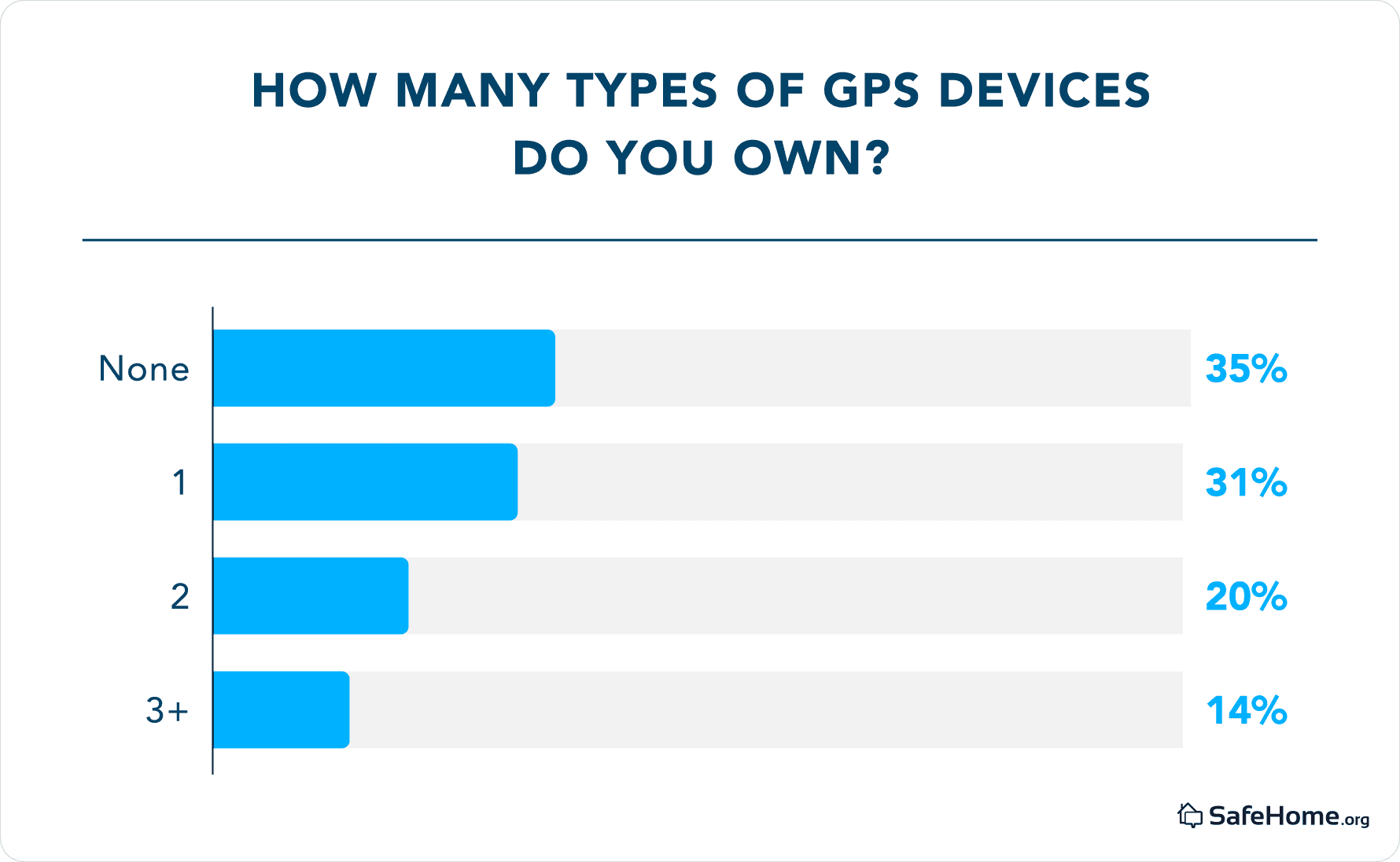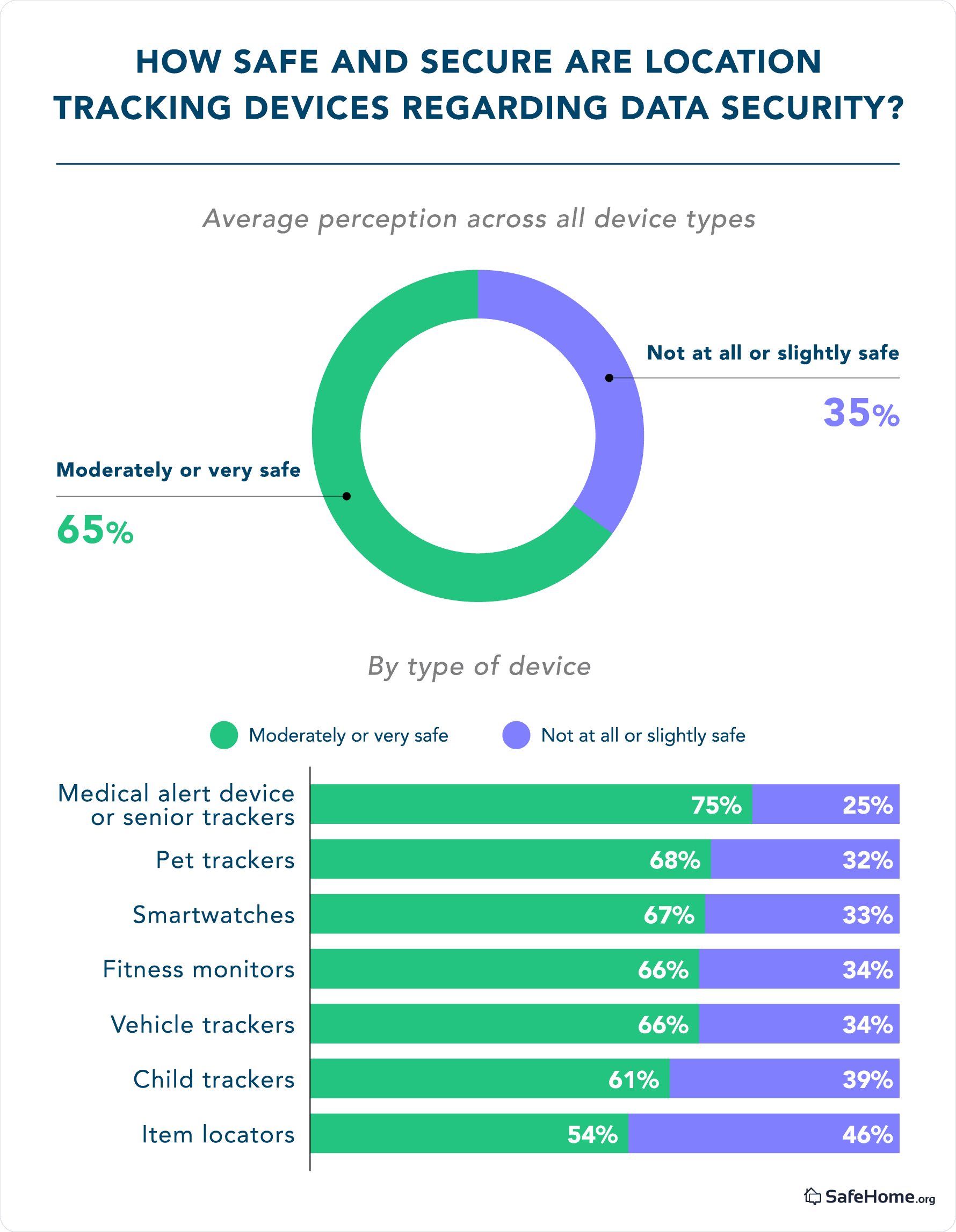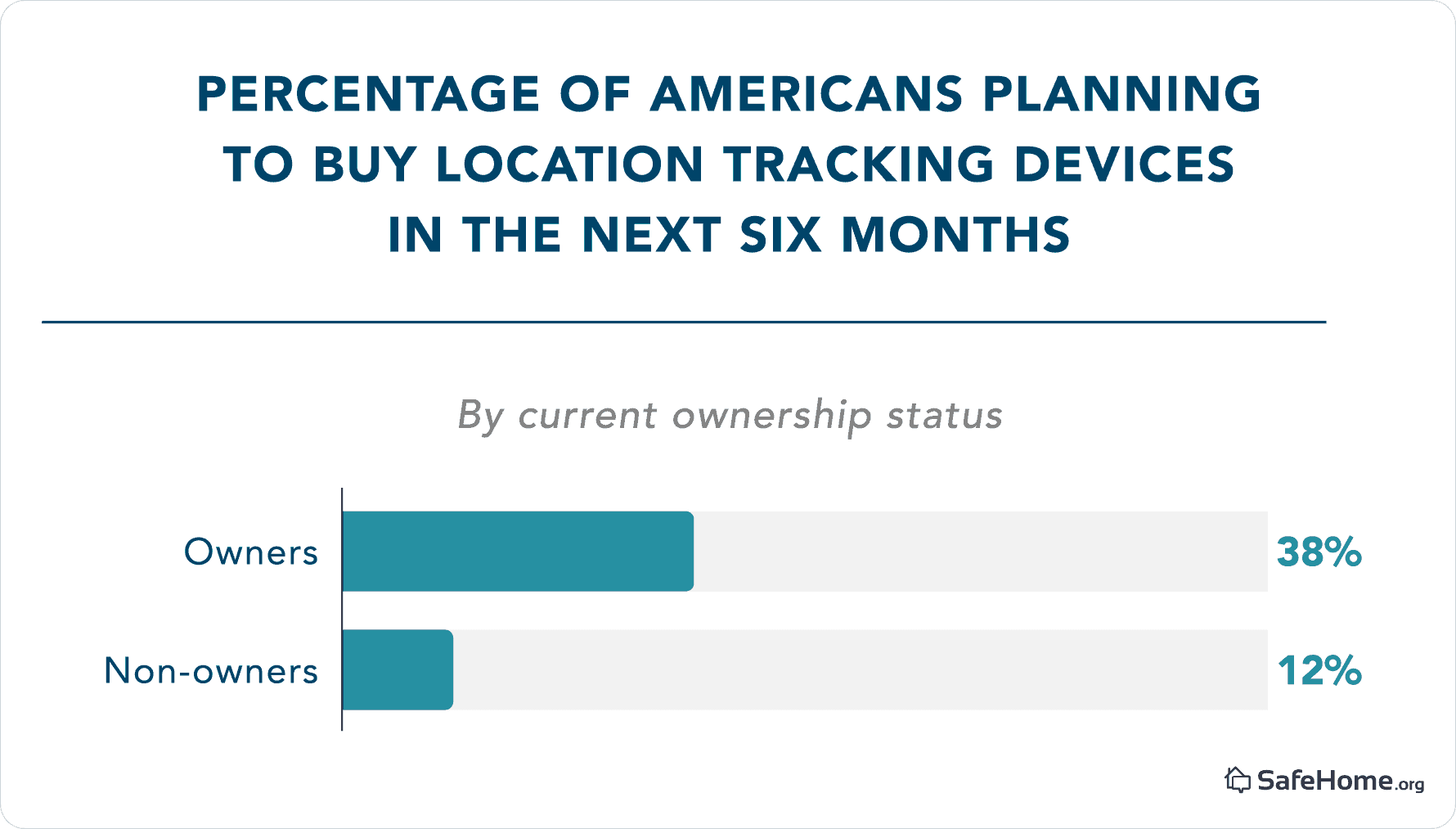170 Million Americans Own GPS Tracking Devices; Market to Grow Over Next Six Months
Universal access to global positioning satellites revolutionized life as we know it. GPS navigation has made our world smaller and more accessible, simplifying trips of all kinds. The next stage of this tech holds equal promise but also carries grave threats.
Portable location trackers precisely monitor movement and can locate lost items, people, and pets. These next-gen devices fit in the palm (or around the wrist) and can trace subjects anywhere on the planet. Such capabilities are a boon to parents, workout warriors, and people who always seem to lose their keys, but they also raise serious privacy issues.
SafeHome.org surveyed over 1,000 adults about a wide range of GPS tools to assess the popularity and public concern surrounding these devices. Read on for the eye-opening results, insight, and buying tips designed to help readers make informed, safe decisions.
Key Findings:
- 170 million Americans own at least one GPS or location-tracking device other than a smartphone.
- More than a quarter of adults plan to buy a location-tracking device in the next six months. Those who already own such a device are much more likely to buy another than those without personal location tools.
- At least 17 million Americans plan to give GPS or location-tracking devices as gifts in the coming months.
- The most popular personal location-tracking devices among Americans are smartwatches, vehicle trackers, and fitness monitors.
- Despite widespread usage, one in three people have serious reservations about the data security of personal location tracking devices. People were most concerned about the security of small item locators and devices used to track children.
A Brief Overview of GPS or Location Tracking Devices
There are a few categories of location-tracking devices on the market today. First are item finders, like Apple AirTags and Tiles. These are used to keep track of the location of important objects like keys or wallets. They use Bluetooth but have limitations like lag and restricted range. They're not ideal for real-time tracking and can be misused. For example, item finders have been used to stalk individuals and target automobiles.
The second type is GPS trackers. These are more advanced than item finders and use satellite and cellular tech for global tracking. They're encrypted for security, provide real-time location within meters, and are now smaller and affordable for personal use, fitting in pockets or on pets. Three major kinds of GPS trackers are designed for personal use: fitness monitors, smartwatches, and location trackers.
Location Tracking Device Ownership
Location trackers' improved utility and affordability have driven strong market growth. Currently, two-thirds of adults (about 170 million Americans) own at least one GPS or other location-tracking product besides their phone.
The number of devices in circulation is even higher, as most users own more than one type of location tracker and many may possess multiple units (especially item locators).
Many people in the country use devices like smartwatches, vehicle trackers, and fitness monitors – almost one-third of the population uses each type. Of all of the location tracking devices included in our analysis, these were the most popular:
- Smartwatches were the most popular devices in our study. They often monitor many of the same functions as fitness devices while supplying the convenience of a smartphone's essential functions at a glance.
- Location trackers serve the narrower function of reporting a geographical position. They can be basic tags or specialized models designed to track vehicles, children, pets, or seniors. Ancillary functions, durability, aesthetics, and mounting options may differ according to use cases. The core GPS components of each are the same.
- Vehicle trackers use GPS location technology to determine and record the precise location of a vehicle in real time, allowing users to monitor its movements and track its location remotely. These trackers are commonly used for fleet management, vehicle security, and personal monitoring.
| Which devices do you own with location or GPS tracking? | Percent of Americans |
|---|---|
| Smartwatch | 29% |
| Vehicle tracker | 28% |
| Fitness monitor | 27% |
| Item locator | 18% |
| Pet trackers | 9% |
| Medical alert device or tracker for seniors | 3% |
| Child tracker | 2% |
| None of the above | 33% |
Note: Multiple responses allowed
There were some demographic differences in which devices people owned. While men tended to prefer smartwatches, women were more likely to own fitness trackers. Younger people, like Generation Z, were likelier to have smartwatches, while Generation X, who may own valuable vehicles, used car trackers most often. Older folks, like Baby Boomers and Generation X, were likelier to have medical alert monitors. Millennials and Generation Xers are in their child-rearing years and thus were most likely to own child trackers.
>> Related: Child Safety Resources
Despite the widespread adoption of consumer GPS tracking products, there remains deep-seated distrust of the devices across all demographic groups.
Location Tracking and Security Concerns
Though most Americans use at least one location-tracking device, many view the tech's capabilities with a wary Orwellian eye. Specifically, more than one in three adults fear that the devices only minimally protect private data. This confidence level in GPS data security was broadly consistent across genders and generations, though Millennials proved the most skeptical age group.
When asked to rate the security of individual tracking devices, consumers had the least confidence in item locators. This is likely due to the tags’ inconspicuous nature, which allows planting and tracking by unwanted parties. Child trackers also raised suspicions, as hacking such devices could permit the illicit monitoring of youngsters. Worries were lower for devices used to track older adults and pets.
Market Outlook for Location-Tracking Devices
GPS-enabled products make great gifts – either as fun personal devices (smartwatches, fitness monitors), to provide peace of mind (child, pet, senior trackers), or to safeguard other presents and possessions (vehicle trackers, item locators).
Over the next six months, 27 percent of Americans plan to buy at least one location-enabled device, with one-quarter purchased as gifts.
Reinforcing the line between GPS tracking acceptance and reluctance, current device owners are three times more likely to make an upcoming purchase than non-owners. Repeat customers will account for 86 percent of near-term sales.
Current GPS device owners’ next purchase will likely be an item locator, presumably because
many already possess smartwatches. New location-tracking customers are most likely to buy their first smartwatch. Here is the expected overall distribution of upcoming GPS device purchases:
| Which location-tracking items will you buy in the next six months? | Percentage of people planning purchases |
|---|---|
| Item locator | 39% |
| Smartwatch | 28% |
| Fitness monitor | 24% |
| Pet trackers | 15% |
| Vehicle tracker | 11% |
| Medical alert device or tracker for seniors | 9% |
| Child tracker | 8% |
Note: Multiple responses allowed
Those familiar with GPS items find them useful, safe, and worth additional purchases. To fully unlock the market, however, manufacturers must overcome the lingering doubts and convert holdouts resisting the allure.
Here are the reasons why many are hesitant to adopt these devices, ranked in order from most to least common:
- Don’t need location-tracking devices
- They’re too expensive
- Don’t want to have location tracked
- Location-tracking devices invade personal privacy
- Location-tracking devices are vulnerable to hacking
- They don’t seem accurate
Despite the holdouts, there are currently 170 million users and 70 million Americans planning new purchases. The growing location tracker industry is in a solid position. More significant strides await if the sector can lower prices, demonstrate utility, and convince the public about device safety and data security.
For those already persuaded to take the plunge on a tracking device, there are several considerations to remember.
Location Tracker Buying Tips
The market offers many options regarding types, brands, models, and prices. To make a good choice, check reviews for a product's performance, durability, and accuracy. Consider these key factors before purchasing:
- Technology: Simple Bluetooth “item finders” are small, inexpensive, and suitable for limited needs. Choose a GPS-enabled device for children, pets, seniors, vehicles, or valuables for accurate, real-time global tracking.
- Connectivity: GPS devices need cellular connections for real-time tracking. Buying from your cell provider simplifies onboarding, while other purchases may require a SIM card and data plan. Be aware of these additional costs.
- Power source: Bluetooth devices use lithium batteries, lasting about a year. GPS trackers, requiring more energy, often have rechargeable batteries. Check battery life before buying and recharge regularly.
- Functionality: Some trackers offer extra features, like boundary warnings or two-way communication. Consider these functions based on your needs and budget.
- User interface: Test the device's interface for responsiveness, intuitiveness, stability, and compatibility with your phone's operating system before purchasing.
- Ease of use: GPS trackers are generally self-sufficient once online, but initial setups can be tricky. If you're not tech-savvy, consider products from trusted brands or buy from your cellular provider.
- Security features: Look for devices with strong safety protocols and strict data privacy policies. Choose trackers with encryption measures and two-factor authorization. Connect only to reputable cellular networks and change default passwords.
Conclusion
The rise of portable location-tracking technology has driven consumer interest while raising safety and ethical dilemmas. Some see the devices as indispensable tools that protect and organize lives. Others view them as privacy-invading security risks contributing to an oppressive surveillance state.
Ultimately, smartphones’ ubiquitous presence demonstrates that Americans have already accepted GPS tethers. Nearly 200 million adults own personal GPS devices, including smartwatches, fitness monitors, item locators, and trackers for children, pets, and seniors. Still, many steadfastly resist this commercial trend. One-third of the country remains reluctant to buy into the hype, holding serious doubts about GPS hacking and data security.
The history of digital technology suggests trackers will continually grow smaller, cheaper, and more practical. This evolution will increase utility while expanding opportunities for abuse. Future technologies might more effectively shield our data, and several jurisdictions are taking legal steps to restrict tracking misuse.
Such reassurances of safety and privacy could further unleash the already robust market that will see 70 million Americans buying devices in the coming six months.
Our Data
In November 2023, SafeHome.org conducted an online poll of 1,025 American adults regarding their ownership status, experience, perceptions, and purchase plans concerning various personal location-tracking or GPS-enabled devices. The respondent pool was evenly divided between men and women. Twelve percent were members of Generation Z, 30 percent were Millennials, 27 percent were members of Generation X, and 26 percent were Boomers. Seventy-four percent of participants were white, six percent were Black, seven percent were of multiple ethnicities, six percent were Asian, and seven percent preferred not to answer or were of another ethnicity.





